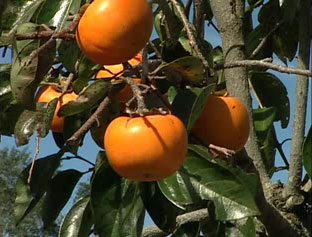Fall is upon us, football is in full swing, and persimmons are ripe on the trees. (That is if you can beat the birds and deer to them.) Persimmons may be a bad memory for some people, because they’ve only ate the astringent American persimmon, Diospyros virginiana. The dry mouth sensation that follows that sweet initial flavor of an American persimmon is very unpleasant. But don’t give up on persimmons until you’ve tried an Oriental persimmon, Diospyrus kaki.
The Oriental persimmon is native to Japan and China. Both astringent and non-astringent varieties are available are on the market. The good thing about non-astringent varieties is they can be eaten when they are still crunchy, before they are fully ripe. This characteristic may appeal to some consumers.
–
Site Preparation and Planting
The American persimmon is the preferred rootstock species for Oriental persimmons. Trees should be ordered early and are usually available in early winter as bare root plants. Trees should be planted upon delivery. Trees should be spaced 15 to 18 feet in rows that are 20 feet apart. Trees should be watered in at planting to allow the soil to settle. Trees should be pruned at planting by cutting the top half out of the tree at the main trunk.
–
Training and Care
Trees should be trained the first few years after planting to create a pyramid shape. This can be achieved by cutting branches back to three to five main limbs at about 1-foot intervals starting at about 3 feet above the ground. Mature trees should be pruned during the winter to maintain form and open the canopy to allow light to penetrate to the fruiting wood. Supplemental irrigation may be required during the spring and summer.
–
Diseases and Insect Pests
Persimmons have few disease and insect pests. Caterpillars, mealy bugs, thrips, and mites have been reported on persimmons, but only in small numbers. Wild animals such as racoons, deer, and birds are more common pests of persimmons than insects. Various fungal leaf spots can cause trees to defoliate early, but treatment is only necessary in severe cases.
–
Varieties
Many non-astringent Oriental persimmons have been developed with ‘Fuyu‘ being the most popular and most readily available in the trade. Other common varieties are ‘Izu‘, ‘Jiro‘, and ‘Ichikikei Jiro‘. Information on other varieties grown in Florida can be found in the publication “Japanese Persimmon Cultivars in Florida“.
- Crops to Consider for Fall Planting - September 26, 2025
- Benefits of Manure Fertilizers and Analysis - March 21, 2025
- Mushrooms – A Crop Worth Consideration for the Back Forty - October 4, 2024

